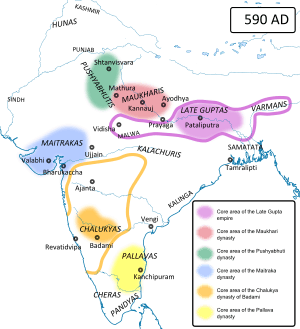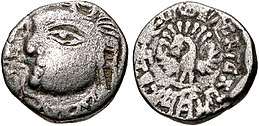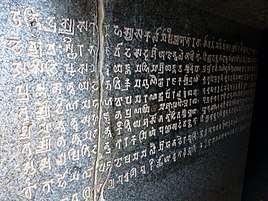Maukhari dynasty
The Maukhari dynasty was a post-Gupta royal Indian dynasty that controlled vast areas of Northern India for over six generations. They earlier served as vassals of the Guptas and later by Harsha's Vardhan dynasty. The Maukharis established their independence at Kannauj, during the 6th century. The dynasty ruled over much of Uttar Pradesh and Magadha. Around 606 CE, a large area of their empire was reconquered by the Later Guptas.[2] According to Huien Tssng, the territory may have been lost to King Shashanka of Gauda, who declared independence circa 600 AD.[3][4]
Maukhari Empire | |||||||||||
|---|---|---|---|---|---|---|---|---|---|---|---|
| c. 550 CE–c. 606 CE | |||||||||||
 Maukharis and their contemporaries in India | |||||||||||
| Capital | Kannauj | ||||||||||
| Common languages | Sanskrit | ||||||||||
| Religion | Hinduism Buddhism | ||||||||||
| Government | Monarchy | ||||||||||
| Maharajadhirajas | |||||||||||
| Historical era | Classical India | ||||||||||
• Established | c. 550 CE | ||||||||||
• Disestablished | c. 606 CE | ||||||||||
| |||||||||||

| Outline of South Asian history | ||||||||||||||||||||||||||||||||||||||||||||
|---|---|---|---|---|---|---|---|---|---|---|---|---|---|---|---|---|---|---|---|---|---|---|---|---|---|---|---|---|---|---|---|---|---|---|---|---|---|---|---|---|---|---|---|---|
_without_national_boundaries.svg.png) | ||||||||||||||||||||||||||||||||||||||||||||
|
Palaeolithic (2,500,000–250,000 BC) |
||||||||||||||||||||||||||||||||||||||||||||
|
Neolithic (10,800–3300 BC)
|
||||||||||||||||||||||||||||||||||||||||||||
|
Chalcolithic (3500–1500 BC)
|
||||||||||||||||||||||||||||||||||||||||||||
|
Bronze Age (3300–1300 BC)
|
||||||||||||||||||||||||||||||||||||||||||||
|
Iron Age (1500–200 BC)
|
||||||||||||||||||||||||||||||||||||||||||||
|
Middle Kingdoms (230 BC – AD 1206) |
||||||||||||||||||||||||||||||||||||||||||||
|
Late medieval period (1206–1526)
|
||||||||||||||||||||||||||||||||||||||||||||
|
Early modern period (1526–1858)
|
||||||||||||||||||||||||||||||||||||||||||||
|
Colonial states (1510–1961)
|
||||||||||||||||||||||||||||||||||||||||||||
|
Periods of Sri Lanka
|
||||||||||||||||||||||||||||||||||||||||||||
|
Specialised histories |
||||||||||||||||||||||||||||||||||||||||||||
Rulers
The known Maukhari rulers of madhya-desha include:[5]
- Hari-varman[6]
- Aditya-varman
- Ishvara-varman (Iśvaravarman)
- Ishana-varman (Iśanavarman), r. c. 550-560 CE
- Sharva-varman (Śarvavarman), r. c. 560-575 CE
- Avanti-varman, r. c. 575-600 CE
- Graha-varman, r. c. 600-605 CE
The Barabar Caves inscriptions attest the existence of another Maukhari branch. This branch ruled as feudatories, probably that of the Later Guptas. The known rulers of this branch include:[7]
- Nrpa Shri Yajna-varman
- Nrpa Samantachudamani Shri Shardula-varman
- Ananta-varman
Inscriptions
 Asirgarh seal inscription of Sarvavarman, Maukhari dynasty, 6th century .
Asirgarh seal inscription of Sarvavarman, Maukhari dynasty, 6th century . Lomas Rishi cave inscription of Anantavarman
Lomas Rishi cave inscription of Anantavarman Gopika Cave Inscription of Anantavarman
Gopika Cave Inscription of Anantavarman Vadathika Cave Inscription of Anantavarman
Vadathika Cave Inscription of Anantavarman
See also
- Megasthenes
- List of Hindu Empires and Dynasties
References
- Tripathi, Rama S. (1989). History of Kanauj: To the Moslem Conquest. Motilal Banarsidass Publ. p. 45 Note 1. ISBN 9788120804043.
- "Maukhari dynasty (Indian dynasty) - Britannica Online Encyclopedia". Britannica.com. Retrieved 2013-01-26.
- Reza, Mohammad Habib; Bandyopadhyay, S.; Mowla, Azizul. "Traces of Buddhist architecture in Gupta and post-Gupta Bengal: evidence from inscriptions and literature". Journal of Eurasian Studies.
- Dasgupta, Biplab. "European Trade and Colonial Conquest, Volume 1". Retrieved 25 April 2020.
- Ronald M. Davidson 2012, p. 34-35.
- Documented by the Shankarpur copper-plate inscription: see SIDDHAM: the asia inscriptions database: https://siddham.network/inscription/in00067/
- Bindeshwari Prasad Sinha (1977). Dynastic History of Magadha, Cir. 450-1200 A.D. Abhinav. pp. 109–110. OCLC 464639312.
Bibliography
- Ronald M. Davidson (2012). Indian Esoteric Buddhism: A Social History of the Tantric Movement. Columbia University Press. ISBN 9780231501026.CS1 maint: ref=harv (link)
External links
- Joseph Schwartzberg. The Historical Atlas of South Asia. Map of the “Age of Pusyabhutis & Calukyans, c. A.D. 550-700”. (Pg 26).